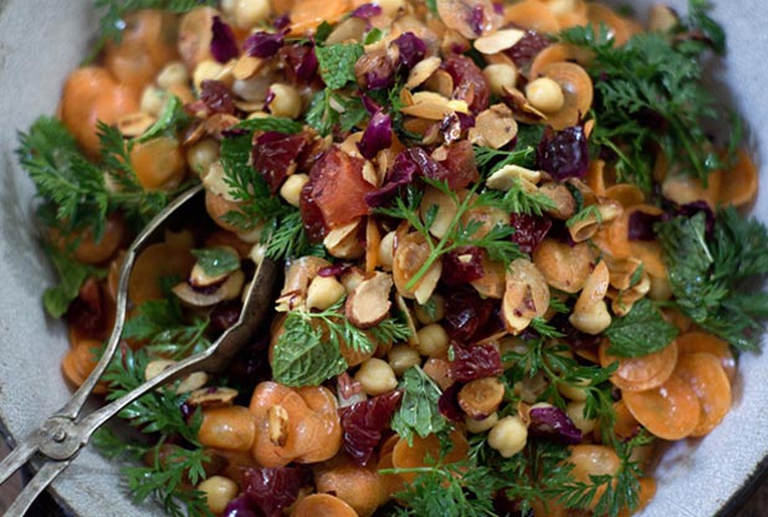
Factory farming conditions and antibiotic-resistant pathogens emerging as a result of them pose an existential threat to humans in the form of zoonotic diseases. Why it’s time to produce and consume food more thoughtfully.
Ingredients 300 g of carrots 2 cups of cooked chickpeas 100 g of prunes juice of a half lemon 4/5 leaves of fresh mint half teaspoonful of cumin seeds cayenne pepper 1 teaspoonful of acacia honey toasted almond flakes rose petals extra virgin olive oil marine salt Preparation Pan-fry the cumin seeds for
Ingredients
300 g of carrots
2 cups of cooked chickpeas
100 g of prunes
juice of a half lemon
4/5 leaves of fresh mint
half teaspoonful of cumin seeds
cayenne pepper
1 teaspoonful of acacia honey
toasted almond flakes
rose petals
extra virgin olive oil
marine salt

Preparation
Pan-fry the cumin seeds for a couple of minutes. When they have cooled grind them in order to obtain a fine powder. In a bowl, emulsify the oil, the lemon juice, the honey, the cumin powder, the salt and the cayenne pepper.
Wash the carrots, and cut them in thin slices. Chop up the prunes. Put the carrots, the chickpeas, the prunes, the mint, and the almonds in a large bowl and pour the seasoning. Mix everything. Season to taste. Serve with rose petals.
Variants
If you want, you can shortly steam the carrots before mixing them to the other ingredients of the Moroccan salad.
Siamo anche su WhatsApp. Segui il canale ufficiale LifeGate per restare aggiornata, aggiornato sulle ultime notizie e sulle nostre attività.
![]()
Quest'opera è distribuita con Licenza Creative Commons Attribuzione - Non commerciale - Non opere derivate 4.0 Internazionale.
Factory farming conditions and antibiotic-resistant pathogens emerging as a result of them pose an existential threat to humans in the form of zoonotic diseases. Why it’s time to produce and consume food more thoughtfully.
The world of cinema recognises the link between food choices and the climate crisis by offering vegan menus for awards season events, including at the most important of them all: the Oscars.
Let’s look at the reasons behind the growth of veganism in India, as a small yet vocal section of the population turns towards this diet and lifestyle in the largest milk producing country in the world.
by Jeffrey Y. Campbell, Manager of the Forest and Farm Facility at FAO In the Ecuadorian Amazon, Kichwa farmers grow dozens of products on tiny parcels of land. Their lands hum with biodiversity, yielding nutritious foods that have sustained families for generations. Wandering among fruit and nut trees and crops, these indigenous agroforesters fill their baskets
Mint has many health benefits, but in food it’s often accompanied by artificial green colourings. Instead, Galatea has created a green mint ice cream in a completely natural way.
We’re talking about Galatea, a company that produces semi-finished products for artisanal ice creams using high quality ingredients, natural colouring, excluding thickeners and hydrogenated fats, respecting the environment and supporting the less fortunate.
The mad rush to fake food, like fake meat made with genetically-modified soy, ignores the importance of the diversity of our foods and culinary cultures. It’s a recipe to accelerate the destruction of the Planet and our health.
Like with all foods, the quality of an ice cream can be discerned by reading its label. An expert explains how to do this, and tells us how their company steers clear of chemicals, using only natural ingredients to produce an excellent and “free” ice cream.
Quality ingredients, no artificial colouring and hydrogenated fats. These are the main features of a great ice cream. But what makes an ice cream parlour “good”, i.e. sustainable?







